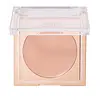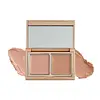What's inside
What's inside
 Key Ingredients
Key Ingredients

 Benefits
Benefits

 Concerns
Concerns

 Ingredients Side-by-side
Ingredients Side-by-side

Ricinus Communis Seed Oil
MaskingOctyldodecyl Stearoyl Stearate
EmollientBis-Diglyceryl Polyacyladipate-2
EmollientRhus Verniciflua Peel Wax
Rhus Succedanea Fruit Wax
Methyl Methacrylate Crosspolymer
Tribehenin
EmollientTocopherol
AntioxidantTocopheryl Acetate
AntioxidantGlycyrrhiza Glabra Root Extract
BleachingMicrocrystalline Wax
Emulsion StabilisingKaolin
AbrasiveTetrahexyldecyl Ascorbate
AntioxidantSilica
AbrasiveMontmorillonite
AbsorbentMagnesium Aluminum Silicate
AbsorbentCaffeine
Skin ConditioningSqualane
EmollientPolyethylene
AbrasiveEthylhexyl Palmitate
EmollientAtelocollagen
Skin ConditioningButylene Glycol
HumectantMica
Cosmetic ColorantPentaerythrityl Tetraisostearate
EmollientSilica Dimethyl Silylate
EmollientSodium Chondroitin Sulfate
Skin ConditioningSodium Hyaluronate
HumectantAscorbyl Palmitate
AntioxidantCaprylyl Glycol
EmollientPhenoxyethanol
PreservativeIron Oxides
CI 77891
Cosmetic ColorantRicinus Communis Seed Oil, Octyldodecyl Stearoyl Stearate, Bis-Diglyceryl Polyacyladipate-2, Rhus Verniciflua Peel Wax, Rhus Succedanea Fruit Wax, Methyl Methacrylate Crosspolymer, Tribehenin, Tocopherol, Tocopheryl Acetate, Glycyrrhiza Glabra Root Extract, Microcrystalline Wax, Kaolin, Tetrahexyldecyl Ascorbate, Silica, Montmorillonite, Magnesium Aluminum Silicate, Caffeine, Squalane, Polyethylene, Ethylhexyl Palmitate, Atelocollagen, Butylene Glycol, Mica, Pentaerythrityl Tetraisostearate, Silica Dimethyl Silylate, Sodium Chondroitin Sulfate, Sodium Hyaluronate, Ascorbyl Palmitate, Caprylyl Glycol, Phenoxyethanol, Iron Oxides, CI 77891
Polyglyceryl-2 Triisostearate
EmulsifyingDiisostearyl Malate
EmollientPolybutene
Triethylhexanoin
MaskingPentaerythrityl Tetraisostearate
EmollientHydrogenated Microcrystalline Cera
Mica
Cosmetic ColorantSilica
AbrasiveIsononyl Isononanoate
EmollientBis-Diglyceryl Polyacyladipate-2
EmollientCopernicia Cerifera Cera
EmollientWater
Skin ConditioningCaprylyl Glycol
EmollientHydroxyacetophenone
AntioxidantTocopheryl Acetate
AntioxidantCI 77891
Cosmetic ColorantCI 77491
Cosmetic ColorantCI 77492
Cosmetic ColorantCI 19140
Cosmetic ColorantCI 42090
Cosmetic ColorantCI 77499
Cosmetic ColorantPolyglyceryl-2 Triisostearate, Diisostearyl Malate, Polybutene, Triethylhexanoin, Pentaerythrityl Tetraisostearate, Hydrogenated Microcrystalline Cera, Mica, Silica, Isononyl Isononanoate, Bis-Diglyceryl Polyacyladipate-2, Copernicia Cerifera Cera, Water, Caprylyl Glycol, Hydroxyacetophenone, Tocopheryl Acetate, CI 77891, CI 77491, CI 77492, CI 19140, CI 42090, CI 77499
Ingredients Explained
These ingredients are found in both products.
Ingredients higher up in an ingredient list are typically present in a larger amount.
This ingredient is lipid-based synthetic skin-conditioning agent derived from adipic acid and a mixture of fatty acids. It is often called a lanolin substitute.
As an emollient, it helps soften and hydrate the skin. Emollients create a barrier on the skin to trap moisture in.
Due to its fatty acid base, it may not be Malassezia folliculitis safe.
Learn more about Bis-Diglyceryl Polyacyladipate-2Caprylyl Glycol is a humectant and emollient, meaning it attracts and preserves moisture.
It is a common ingredient in many products, especially those designed to hydrate skin. The primary benefits are retaining moisture, skin softening, and promoting a healthy skin barrier.
Though Caprylyl Glycol is an alcohol derived from fatty acids, it is not the kind that can dry out skin.
This ingredient is also used as a preservative to extend the life of products. It has slight antimicrobial properties.
Learn more about Caprylyl GlycolCi 77891 is a white pigment from Titanium dioxide. It is naturally found in minerals such as rutile and ilmenite.
It's main function is to add a white color to cosmetics. It can also be mixed with other colors to create different shades.
Ci 77891 is commonly found in sunscreens due to its ability to block UV rays.
Learn more about CI 77891Mica is a naturally occurring mineral used to add shimmer and color in cosmetics. It can also help improve the texture of a product or give it an opaque, white/silver color.
Serecite is the name for very fine but ragged grains of mica.
This ingredient is often coated with metal oxides like titanium dioxide. Trace amounts of heavy metals may be found in mica, but these metals are not harmful in our personal products.
Mica has been used since prehistoric times throughout the world. Ancient Egyptian, Indian, Greek, Roman, Aztec, and Chinese civilizations have used mica.
Learn more about MicaPentaerythrityl Tetraisostearate is derived from isostearic acid. It is an emollient and emulsifier.
The highest concentration of this ingredient is found in lipsticks.
This ingredient is minimally water soluble and may not be Malassezia folliculitis, or fungal-acne safe.
Learn more about Pentaerythrityl TetraisostearateSilica, also known as silicon dioxide, is a naturally occurring mineral. It is used as a fine, spherical, and porous powder in cosmetics.
Though it has exfoliant properties, the function of silica varies depending on the product.
The unique structure of silica enhances the spreadability and adds smoothness, making it a great texture enhancer.
It is also used as an active carrier, emulsifier, and mattifier due to its ability to absorb excess oil.
In some products, tiny microneedles called spicules are made from silica or hydrolyzed sponge. When you rub them in, they lightly polish away dead skin layers and enhance the penetration of active ingredients.
Learn more about SilicaTocopheryl Acetate is AKA Vitamin E. It is an antioxidant and protects your skin from free radicals. Free radicals damage the skin by breaking down collagen.
One study found using Tocopheryl Acetate with Vitamin C decreased the number of sunburned cells.
Tocopheryl Acetate is commonly found in both skincare and dietary supplements.
Learn more about Tocopheryl Acetate